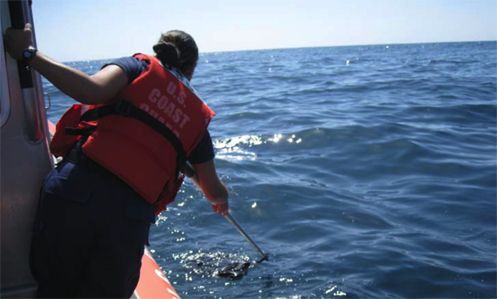U.S. Coast Guard photo

US Sailing, the governing body of sailing in the U.S., has released the results of its investigation into the sailing accidentin which four sailors diedduring the 2012 Newport to Ensenada race. The victims were crew aboard Aegean, a 37-foot Hunter 376 participating in the 125-mile race from Newport Beach, Calif., to Ensenada, Mexico. The annual race is organized by the Newport Ocean Sailing Association (NOSA).
A U.S. Coast Guard inquiry into the accident is ongoing.
Although very early reports suggested Aegean collided with a ship, the panel concluded in June that the Aegean had mysteriously grounded on North Coronado Island. Data gathered from a SPOT Connect (a GPS tracking device with texting capability) indicated that the boat grounded on the island shortly after 1:30 a.m. on April 28 in relatively calm winds. Debris was later found on the island and in the water near the island. (Practical Sailor will be reporting on its field trials with the SPOT Connect in the January issue.)
In the carefully worded report, the panel cited inadequate lookout as a key factor that likely contributed to the accident. It also found that it was likelyAegean inadvertently motored beyond a waypoint set near North Coronado Island.
As the report states: Based on all factors, the panel concludes that the skipper set a waypoint that took Aegean on a path that intersected North Coronado Island, that Aegean was motoring under autopilot as she approached the island, and there is no evidence of any intervention to prevent Aegeans running into the island.
The only suggestion that someone was asleep at the wheel came from a column published in a local newspaper that was included in the appendix of the US Sailing report.
There were no surviving eyewitnesses to the accident, so the panel based its conclusions on a range of sources, including: data collected from the SPOT Connect, published material, press reports, interviews with race organizers, race participants, past crew from Aegean, and wreckage found at North Coronado Island and in the debris field.
Although the report provides a timeline for the response fromGEOS, the monitoring service that handles distress alerts from the SPOT Connect, it does not critique the actions that GEOS took. Practical Sailor examined the GEOS response in August 2012.
The report, does, however, point out weaknesses in the SPOT tracking system: The panels review showed that information generated by the SPOT Connect was highly accurate in terms of location and time, but unreliable in transmission of position fixes on a timely basis.
As a result of its finding, the panel has recommended improvements in the following areas:
- NOSA should include a segment on safety training in their Pre-Race Seminar.
- Always maintain a lookout, with a watch of at least two people, using audible waypoint and radar alarms.
- Racers need to be made aware of the light obscuration zones in the Coronado Islands.
- Each watch must understand the operation of the boat’s navigation systems.
- The use of autopilots while motoring should be reviewed by race organizers, and sailing instructions should specifically address the skippers responsibility while the boat is operating under autopilot.
- To improve communication, racers should monitor VHF 16 and race organizers should provide a 24-hour emergency contact.
- US Sailing should create a guide to emergency signaling devices.
- US Sailing should create a crisis management template for race organizers.
In a publicly released statement, US Sailing Panel Chairman Bruce Brown offered condolences to the family of the victims.
The US Sailing Independent Review Panel members express our sorrow at the loss of four lives in this tragic accident, Brown said. We offer our condolences to the family members of the victims. This accident was tragic, and we will not know what occurred during the last hours on board Aegean.
The US Sailing website has more information on this and other US Sailing Safety Reports.




































